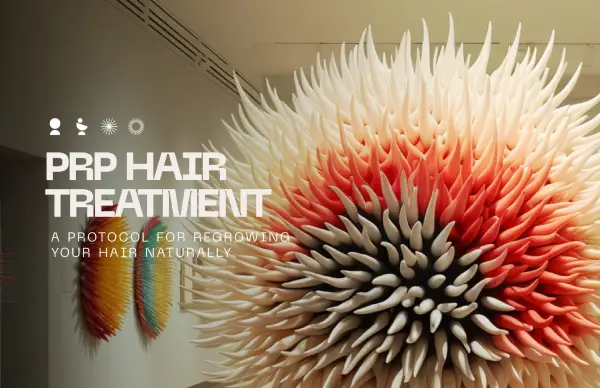Blog
PRP Hair – does it work?

Contents
What is PRP?
What is PRP therapy?
PRP hair treatment: Regrowing hair naturally
How does PRP therapy help with hair restoration?
PRP vs. hair transplant: Choosing the right option
Is PRP hair treatment suitable for men and women?
PRP for hair loss in women: Success stories
What is the typical duration of PRP treatment sessions?
Are there any side effects or risks associated with PRP hair restoration?
How long does it take to see results from PRP hair treatment?
The lowdown on PRP and hair loss
Platelet-rich plasma is a cutting-edge technology that offers several benefits, but does PRP work for hair loss?
Statistics show baldness is a problem for around 50 million men and 30 million women in the US alone. It’s more common in people over 50 and compounded by stress.
This distressing ailment has sparked a variety of treatment options. Some are less effective, but others offer real options that could provide improvement.
Current PRP applications exist in diverse medical fields, including dermatology. Interest has grown, with promising results in the treatment of alopecia. Read on to learn how PRP works.
What is PRP?
Platelet-rich plasma (PRP) has several names. Some call it platelet-rich growth factors (GFs), platelet-rich fibrin (PRF), or platelet concentrate.
Hematologists coined the phrase in the 1970s. It denotes plasma with a higher platelet count than regular blood.
The liquid part of blood is plasma. It consists mainly of proteins and water, offering a home for red and white blood cells. They circulate the body along with platelets crucial to natural healing processes.
Doctors extract the platelet-rich plasma protein from whole blood. Injecting PRP may deliver anti-inflammatory effects and spark cell production.
Sports doctors have used it extensively to treat muscle and skeletal injuries. Widespread media attention has expanded use and interest. PRP plays a part in cardiac, pediatric, and plastic surgery. It also plays a role in gynecology, urology, and ophthalmology.
What is PRP therapy?
PRP therapy involves injecting concentrated platelets to speed recovery from injuries or disease. It utilizes and magnifies the patient’s natural healing process. Experts inject the plasma into tendons, ligaments, muscles, joints, or other soft tissues.
Doctors take a few tubes of blood and run it through a centrifuge twice. This first separates the red blood cells. Double centrifugation concentrates the platelets in the smallest possible amount of plasma.
Specialists inject the PRP directly into the injured or diseased area. The activated platelets produce growth factors that may boost reparative cell production. Evidence suggests this therapy can significantly speed up recuperation.
PRP joint injections for tendon ruptures and rotator cuff issues are commonplace. Tendonitis and inflammation issues, like tennis elbow, also show improvement and pain reduction. PRP facial injections are also gaining traction for various skincare concerns.
This treatment may boost your healing processes, but does PRP work for hair loss?
PRP hair treatment: Regrowing hair naturally
PRP treatments started decades ago. They focused on boosting cell growth to heal wounds and skeletomuscular injuries. Experimentation showed an unexpected potential for combating hair loss.
Further trials centered mainly on androgenetic alopecia (AGA). Also called hormone related baldness, it affects men and women. This condition relates to increased levels of the hormone androgen. It impacts the growth cycle of hair and the follicles, causing thinning and baldness.
In men, thinning usually occurs on the front and top of the head in a typical M-shape. In women, a widening parting is the warning, while the crown takes the brunt.
PRP therapy for hair may:
- Improve general scalp health.
- Reactivate dormant hair follicles.
- Eliminate the need for daily drug schedules.
- Reduce the rate of hair loss.
- Thicken hair.
Once they extract the PRP, doctors inject it into bald areas on the scalp. Some use microneedling in tandem to boost collagen production. Most uses are cosmetic, but some can be medical.
You can also use PRP with a hair transplant or a daily drug regimen. The combinations may provide improved results.
PRP costs vary with the extent of the problem and your location. It can also depend on the company or institution treating you.
How does PRP help with hair restoration?
Doctors began using platelet-rich plasma decades ago to treat musculoskeletal problems. There’s potential for dermatological benefits, like improved skin appearance and texture. More intriguing are the possibilities for managing hair loss.
Platelets are crucial to soft tissue growth and wound healing. They activate proteins called growth factors. They stimulate growth of special dermal papilla cells. PRP concentrates around five times the platelets present in regular blood.
Medical professionals usually apply a topical numbing cream before this procedure. A trained clinician injects the PRP with a small needle into the prescribed area. It contains an anticoagulant to ensure the highest concentration of growth factors.
Practitioners aim PRP deep under the scalp to stimulate the bottom of the follicle. It boosts dermal stem cell production, which promotes new hair growth. It may also activate previously dormant follicles.
The entire process takes about half an hour. The numbing cream reduces discomfort. Patients can continue their regular schedule after PRP hair therapy.
PRP treatment strengthens the hair follicle and boosts hair development and thickness. Doctors may suggest PRP in tandem with microneedling. This collagen induction therapy (CIT) involves puncturing the skin with tiny needles. It stimulates the skin’s natural healing process.
The tiny needles make microscopic holes in the skin to erase acne marks, scars, or stretch marks. Microneedling is minimally invasive and encourages elastin and collagen production for better skin texture. Some patients use it to remove blemishes or discolorations.
PRP vs. hair transplant: Choosing the right option
Hair transplants are another popular method of treatment. They work well with bald spots that have no hair follicles. PRP needs a dormant follicle at the bare minimum for success.
Extensive alopecia areata occurs when the immune system mistakenly attacks hair follicles. The reasons are environmental and hereditary. Science can’t yet narrow it down further.
With extensive baldness, clinicians must seed the area with transplanted hair follicles. Several professionals perform transplants in conjunction with PRP treatments. The combination offers all the components they need to thrive.
Is PRP hair treatment suitable for men and women?
Tests show that platelet-rich plasma effectively treats male and female pattern hair loss. That’s excellent news for around 80 million Americans with this upsetting condition.
While most common after age 50, some people have to deal with it in their 20s. PRP offers a low risk, high reward option with no major side effects. Most trials target PRP influences on androgenic alopecia.
PRP may work best in combination with other treatments. One trial reported effective results with PRP in tandem with two drugs. FDA-approved oral finasteride and topical minoxidil both show improved effectiveness.
PRP for hair loss in women: Success stories
Hair loss impacts around 30 million American women. It can be distressing, but platelet-rich plasma is an effective option. The treatment improves hair density when treating female pattern hair loss (FPHL).
FPHL is most common among middle-aged women. Scientists reckon it’s down to genetics, environmental conditions, and hormone levels. Many PRP hair before and after photos display impressive results.
Estrogen variances and thyroid issues can thin hair. A lack of iron and other hormone imbalances can cause excess hair shedding. Growth factors could reverse the damage done by temporary hormone changes.
An example is the case of Dr. Desiree Yazdan. She experienced progressive hair loss during pregnancy. Four sessions of PRP rectified the issue. Platelet-rich-plasma treatment restored her hair, especially around the temples. The new growth was straight, thick, and healthy.
Clinically, there’s mounting evidence that PRP treatments offer positive reactions. These objective results show increased hair density and thickness. Of 30 evaluated trials, 29 reported benefits, with 24 being statistically significant. Efficiency is similar for men and women.
Trials note high patient satisfaction and an exceptional safety profile. PRP treatment is a valuable, effective, and safe treatment option for men and women.
What is the typical duration of PRP treatment sessions?
Treating hair loss with pharmaceutical drugs demands daily and continuous therapy. There are also potential side effects to consider. PRP treatments are low risk. The process is much more convenient and has no severe downsides.
PRP limits hair loss and promotes growth. The typical schedule involves 3–4 initial sessions a month apart. The effects can last up to 18 months, but most patients have a yearly check-up. Clinicians generally offer follow-up maintenance sessions every 3–6 months.
This treatment stimulates your natural ability to heal and enhances health. Trained practitioners infuse this platelet-rich plasma for therapeutic and aesthetic reactions. Injecting PRP under the scalp takes half an hour in most cases.
Are there any side effects or risks associated with PRP hair restoration?
The side effects of PRP are limited. This therapy involves parts of your own blood, so there aren’t rejection issues. Scientists consider it a safe, effective treatment that prevents the need for steroids.
The main problems are typical of injection-based therapies. The treatment may cause tolerable and temporary pain. Some patients report mild headaches, itching, or bruising. Edema (swelling or fluid retention) and transient erythema (skin reddening) are also possible.
By contrast, drug therapy may cause scalp irritation, dermatitis, or an upset stomach. Nausea and even sexual dysfunction could also occur.
How long does it take to see results from PRP hair treatment?
It can take three sessions or more before you see general improvement. Document your progress with PRP hair before and after pictures to stay motivated.
Some patients report improved texture and regrowth within a fortnight. Others need several weeks before noticing the impact of a session. It takes 4–6 weeks to grow new hair from the original therapy.
PRP boosts collagen production, which improves hair health and increases growth. It takes time to see measurable results from PRP for hair restoration. Visual changes could take 6–12 months.
The lowdown on PRP and hair loss
So, does PRP work for hair loss? Trials conclude PRP treatment is a viable option for diseases like alopecia areata. It’s also an option for male or female pattern baldness (androgenetic alopecia).
The process halts hair loss and promotes new growth by increasing follicle numbers. Scientists consider PRP low risk as it uses your own natural blood products, so your body won’t reject it.
PRP is a safe and effective treatment method with no downtime. You can incorporate it as a primary regimen or in combination with other treatments.
Book an assessment at LIVV Natural today. We’re the prime destination for ultimate wellness.
Author: Dr. Jason Phan NMD – Founder of LIVV Natural – Anti-aging – regenerative medicine – peptide therapy


